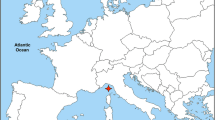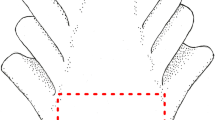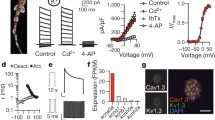Abstract
Selection to maximize electroreceptive search area might have driven evolution of the cephalofoil head morphology of hammerhead sharks (family Sphyrnidae). The enhanced electrosensory hypothesis predicts that the wider head of sphyrnid sharks necessitates a greater number of electrosensory pores to maintain a comparable pore density. Although gross head morphology clearly differs between sphyrnid sharks and their closest relatives the carcharhinids, a quantitative examination is lacking. Head morphology and the distribution of electrosensory pores were compared between a carcharhinid, Carcharhinus plumbeus, and two sphyrnid sharks, Sphyrna lewini and S. tiburo. Both sphyrnids had greater head widths than the carcharhinid, although head surface area and volume did not differ between the three species. The raked head morphology of neonatal S. lewini pups, presumably an adaptation to facilitate parturition, becomes orthogonal to the body axis immediately post-parturition whereas this change is much less dramatic for the other two species. The general pattern of electrosensory pore distribution on the head is conserved across species despite the differences in gross head morphology. Sphyrna lewini has a mean of 3067 ± 158.9 SD pores, S. tiburo has a mean of 2028 ± 96.6 SD pores and C. plumbeus has a mean of 2317 ± 126.3 SD pores and the number of pores remains constant with age. Sphyrnids have a greater number of pores on the ventral surface of the head whereas C. plumbeus has an even distribution on dorsal and ventral surfaces. The greater number of pores distributed on a similar surface area provides S. lewini pups with a higher density of electrosensory pores per unit area compared to C. plumbeus pups. The greater number of ampullae, the higher pore density and the larger sampling area of the head combine to provide hammerhead sharks with a morphologically enhanced electroreceptive capability compared to comparably sized carcharhinids.
Similar content being viewed by others
References
Castro, J.I. 1983. The sharks of North American waters. Texas A&M University Press, College Station. 180 pp.
Chu, Y.T. & M.C. Wen. 1979. Monograph of fishes of China (No. 2): a study of the lateral-line canals system and that of Lorenzini ampulla and tubules of elasmobranchiate fishes of China. Science and Technology Press, Shanghai. 132 pp.
Clarke, T.A. 1971. The ecology of the scalloped hammerhead shark, Sphyrna lewini, in Hawaii. Pac. Sci. 25: 133–144.
Compagno, L.J.V. 1984. FAO species catalogue, vol. 4. Sharks of the world. Food and Agriculture Organization of the United Nations, Rome. 655 pp.
Cortes, E., C.A. Manire & R.E. Hueter. 1996. Diet, feeding habits, and diel feeding chronology of the bonnethead shark, Sphyrna tiburo, in southwest Florida. Bull. Mar. Sci. 58: 353–367.
Daniels, C.I. 1967. The distribution, morphology, and innervation of the ampullae of Lorenzini in the hammerhead shark and other species. MS Thesis, University of Hawaii, Honolulu. 42 pp.
Gilbert, C.R. 1967. A revision of the hammerhead sharks (family Sphyrnidae). Proc. U.S. Nat. Mus. 119: 1–98.
Johnson, P.B. & J.H. Teeter. 1985. Behavioral response of bonnethead sharks (Sphyrna tiburo) to controlled olfactory stimulation. Mar. Behav. Physiol. 11: 283–291.
Medved, R.J., C.E. Stillwell & J.J. Casey. 1985. Stomach contents of young sandbar sharks, Carcharhinus plumbeus, in Chincoteague Bay, Virginia. U.S. Fish. Bull. 83: 395–402.
Murray, R.W. 1974. The ampullae of Lorenzini. pp. 125–146. In: A. Fessard (ed.) Handbook of Sensory Physiology, vol. 3, Springer-Verlag, New York.
Nakaya, K. 1995. Hydrodynamic function of the head in the hammerhead sharks (Elasmobranchii: Sphyrnidae). Copeia 1995: 330–336.
Naylor, G.J.P. 1992. The phylogenetic relationships among requiem and hammerhead sharks: inferring phylogeny when thousands of equally most parsimonious trees result. Cladistics 8: 295–318.
Obara, S. & M.V.L. Bennett. 1972. Mode of operation of ampullae of Lorenzini of the skate, Raja. J. Gen. Physiol. 60: 534–557.
Raschi, W.G. 1978. Notes on the gross functional morphology of the ampullary system in two similar species of skates, Raja erinacea and R. ocellata. Copeia 1978: 48–53.
Raschi, W.G. 1984. Anatomical observations on the Ampullae of Lorenzini from selected skates and galeoid sharks of the Western North Atlantic. Ph.D. Dissertation, College of William and Mary, Williamsburg. 116 pp.
Raschi, W.G. 1986. A morphological analysis of the ampullae of Lorenzini in selected skates (Pisces, Rajoidei). J. Morph. 189: 225–247.
Strong, W.R., F.F. Snelson, Jr. & S.H. Gruber. 1990. Hammerhead shark predation on stingrays: an observation of prey handling by Sphyrna mokarran. Copeia 1990: 836–840.
Tester, A.L. 1963. Olfaction, gustation and the common chemical sense in sharks. pp. 255–285. In: P.W. Gilbert (ed.) Sharks and Survival, D.C. Heath and Company, Boston.
Thomson, K.S. & D.E. Simanek. 1977. Body form and locomotion in sharks. Amer. Zool. 1977: 343–354.
Author information
Authors and Affiliations
Rights and permissions
About this article
Cite this article
Kajiura, S.M. Head Morphology and Electrosensory Pore Distribution of Carcharhinid and Sphyrnid Sharks. Environmental Biology of Fishes 61, 125–133 (2001). https://doi.org/10.1023/A:1011028312787
Issue Date:
DOI: https://doi.org/10.1023/A:1011028312787




